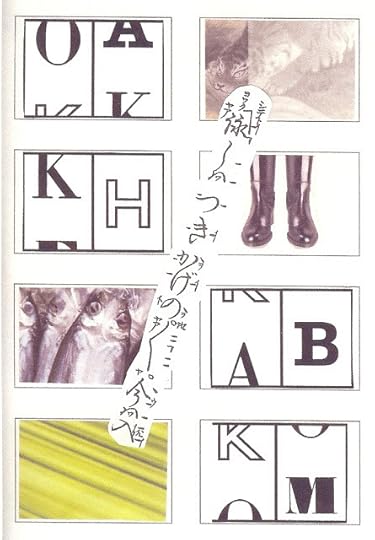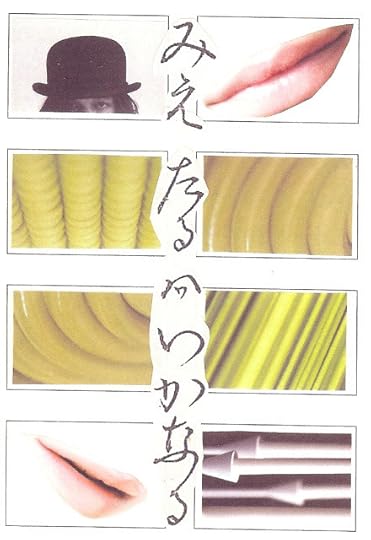At the End We Have Collage because Collage is All There Is
Harlem, New York, New York

Starting in January, Lynn Behrendt and Anne Gorrick, the proprietors of Peep/Show, the online journal of textual and visual seriality, began to present to the world an issue on international visual poetry that I curated, and now, in July, all ten of those series of works are available online.
The final installation to this online exhibit is the collage work of Keiichi Nakamura, and I think it's some of the best work he has ever done.
There is a bit of magic to collage, how it takes disparate fragments of the reality we stumble across every day and arranges these into a whole that coheres even as it struggles to tear itself apart and free its pieces to return to their own rightful places in this indistinct world of ours.
There's a little bit of Magritte in these collage poems, a bit of discontinuity, a bit of surrealism, a bit of the need to define and understand and name the world. So it is not only the bowler hat that makes me see this. These collages are divided into two columns, each with a stack of four images (some of them images of text), and each of these columns is stitched together, almost literally, by a bit of text in Japanese. The rectangles of images are, in part, pieces of a clear set, and sometimes seemingly random images, and the text that stitches them together is sometimes itself in columns, and sometimes a single column of Japanese cutting straight through the gap between the columns or set off at an angle.
Unfortunately, I am sure that knowledge of Japanese would help me understand these works better and make better sense of them, just as with Magritte we are occasionally required to understand French to understand his paintings. In visual poetry, the words that appear within the frame of a composition always carry some meaning and, frequently enough, that meaning is linguistic. Still, these poems of Nakamura's are significantly visual, so we know how to read them well enough.
Keiichi Nakamura's series of visual poems is the last of the ten in this issue of Peep/Show, which I devised to give people a sense of the geographic and esthetic breadth of visual poetry today. This issue of Peep/Show has some very textual works that are almost not visual at all, it includes asemic works at the farthest edge of the non-representationalism of written language, it includes works of what we might call code poetry, it includes a wide variety of styles, and it includes two other notable features: First, I made sure that half the participants were female and half were male, so that people would understand that visual poetry is less a male-dominated domain than it has been for most of the past seventy years. Second, it includes no work from North America, because the editors wanted this to focus on the rest of the world, but it includes work from every other continent except for Antarctica and Africa. It remains desperately difficult to find African visual poetry, though if I were putting this together today there is a female South African mailartist whose work I would definitely included.
Visual poetry is an international poetry in two ways: It is a poetry that now covers the globe, and those of us working in visual poetry are usually connected to visual poets in many other countries. Because visual poetry is not focused on individual language; it is focused on the poetry itself.

ecr. l'inf.

Starting in January, Lynn Behrendt and Anne Gorrick, the proprietors of Peep/Show, the online journal of textual and visual seriality, began to present to the world an issue on international visual poetry that I curated, and now, in July, all ten of those series of works are available online.
The final installation to this online exhibit is the collage work of Keiichi Nakamura, and I think it's some of the best work he has ever done.
There is a bit of magic to collage, how it takes disparate fragments of the reality we stumble across every day and arranges these into a whole that coheres even as it struggles to tear itself apart and free its pieces to return to their own rightful places in this indistinct world of ours.
There's a little bit of Magritte in these collage poems, a bit of discontinuity, a bit of surrealism, a bit of the need to define and understand and name the world. So it is not only the bowler hat that makes me see this. These collages are divided into two columns, each with a stack of four images (some of them images of text), and each of these columns is stitched together, almost literally, by a bit of text in Japanese. The rectangles of images are, in part, pieces of a clear set, and sometimes seemingly random images, and the text that stitches them together is sometimes itself in columns, and sometimes a single column of Japanese cutting straight through the gap between the columns or set off at an angle.
Unfortunately, I am sure that knowledge of Japanese would help me understand these works better and make better sense of them, just as with Magritte we are occasionally required to understand French to understand his paintings. In visual poetry, the words that appear within the frame of a composition always carry some meaning and, frequently enough, that meaning is linguistic. Still, these poems of Nakamura's are significantly visual, so we know how to read them well enough.
Keiichi Nakamura's series of visual poems is the last of the ten in this issue of Peep/Show, which I devised to give people a sense of the geographic and esthetic breadth of visual poetry today. This issue of Peep/Show has some very textual works that are almost not visual at all, it includes asemic works at the farthest edge of the non-representationalism of written language, it includes works of what we might call code poetry, it includes a wide variety of styles, and it includes two other notable features: First, I made sure that half the participants were female and half were male, so that people would understand that visual poetry is less a male-dominated domain than it has been for most of the past seventy years. Second, it includes no work from North America, because the editors wanted this to focus on the rest of the world, but it includes work from every other continent except for Antarctica and Africa. It remains desperately difficult to find African visual poetry, though if I were putting this together today there is a female South African mailartist whose work I would definitely included.
Visual poetry is an international poetry in two ways: It is a poetry that now covers the globe, and those of us working in visual poetry are usually connected to visual poets in many other countries. Because visual poetry is not focused on individual language; it is focused on the poetry itself.

ecr. l'inf.
Published on July 10, 2011 08:19
No comments have been added yet.



